Interview: Peter Thommen & Werner Gnigler - early gliding in light winds
Stephan Gölnitz
· 13.07.2025
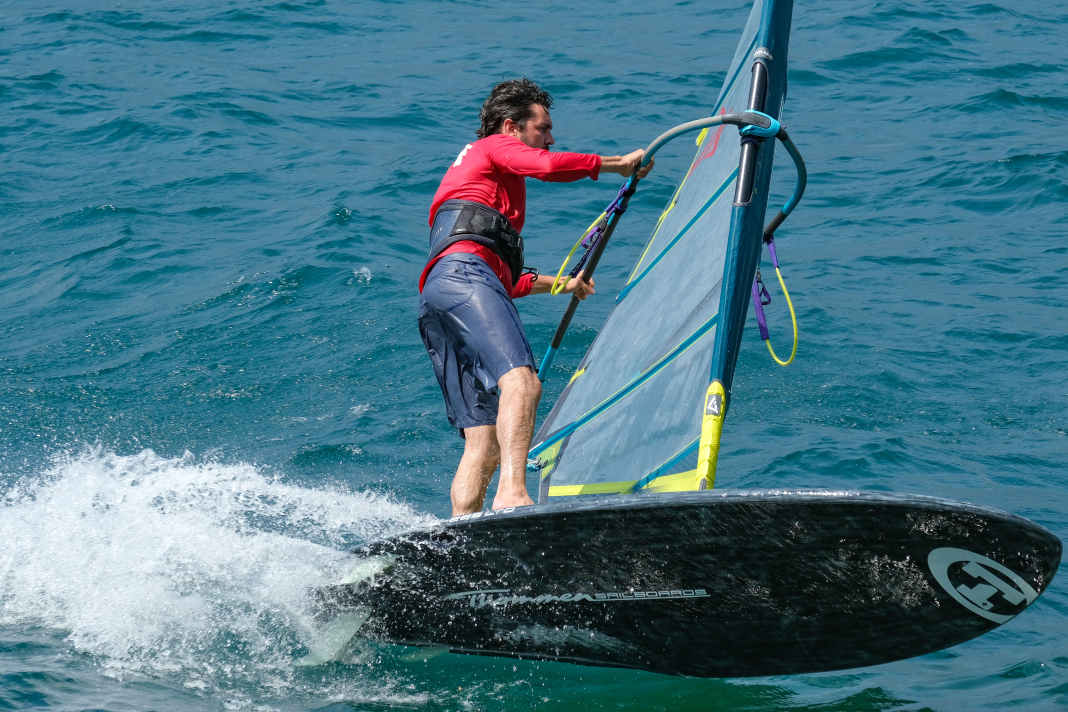





- Interview with Peter Thommen - about the missing link in windsurfing equipment
- The Thommen method: more length and three fins
- JP-Australia Magic Ride or Super Lightwind? Shaper Werner Gnigler gives you first-hand information here.
- The JP-Australia Super Lightwind compared to a slalom board
When Peter Thommen was still developing the victorious F2 World Cup boards for Björn Dunkerbeck, Werner Gnigler was the shaper for the masses - the man behind the everyday and popular models such as the F2 Xantos. Since the founding of the JP-Australia brand, all JP boards have borne his signature, while Peter "Thommen" works under his own name. In the upcoming surf issue August 2025, two current models from the two successful shapers are in a comparison test, here they talk about their shape trends for light winds.
Interview with Peter Thommen - about the missing link in windsurfing equipment
We caught Peter Thommen by email and would like to share his detailed, versatile and interesting observations on relaxed gliding in the lightest of winds. You can find a detailed test of the 2.65 metre long and 82 centimetre wide special shape Glide 165, also known as the "gliding miracle", in surf 8/2025 and soon online.
Peter, you have been working intensively on the development of a board concept for easy planing in light winds. What was the trigger for this?
It all began with the realisation of some facts and observations about the windsurfing board market - and also with the comments and expectations of the windsurfing community and their interpretation by the various players in this field.
What are these observations?
For example, it has been evident for decades that windsurfing centres and schools consistently have good to excellent customer numbers - year after year. And then there is a difference to other wind sports: kiteboarding and now also wingboarding schools not only manage to sell their beginner courses, but also actually produce active athletes on a permanent basis. Unfortunately, this aspect is less common in windsurfing. After the first course, there is often a lack of connection between the schools and the new windsurfing beginners.
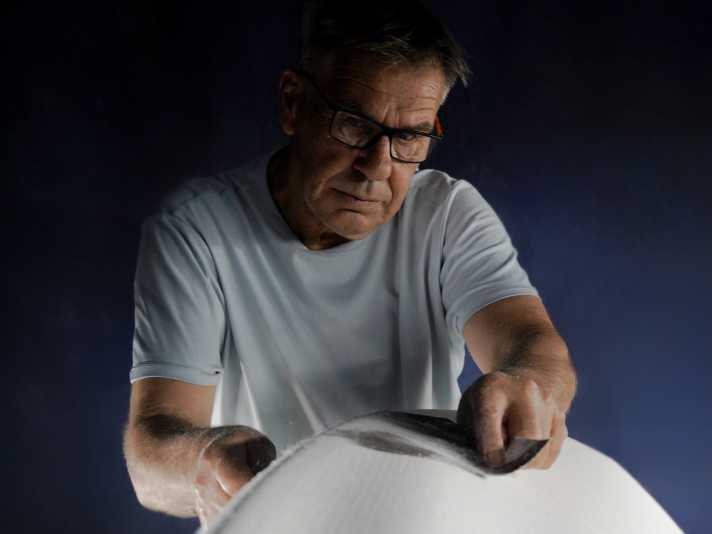
One major problem is the high barrier to entry into glide surfing.
Why do you think that is?
There are many reasons for this - some are interrelated, others are more coincidental. I will limit myself here to the equipment-related aspects. One major problem is the high barrier to entry into glide surfing. The path to the first "wow" moment that captivates you takes longer than with other sports. There is also a lot of confusion about the right equipment. Although many schools recommend what they consider to be "good" boards, these are often completely unsuitable for learning quickly, easily and effectively. The leap from a super-stable beginner board to a medium-sized freeride board is too big for many new windsurfers.
So the material is the bottleneck?
Exactly. Over the years, I've noticed that as well as newcomers, there are also a lot of "returnees" who have taken a break for a few years and can't cope with the current, short and wide boards. They are frustrated, often hopeless - but also don't want to go back to classic "old school" equipment. What was missing was an intermediate step - a modern, inviting board that would allow them to progress and have fun at the same time. Not just a board for beginners, but something that builds a bridge.
The Thommen method: more length and three fins
What was your solution approach?
I wanted a board that was not only "early", but above all simple starts to glide. To achieve this, I have combined principles from the past with new ideas. For example: Twenty centimetres more length than usual - a break with the standards, but a sensible one. This allows you to stretch the rocker and, above all, make the entry angle flatter, making it easier to overcome your own bow wave - in other words, easier to get into the planing phase.
With a longer board you can flatten the entry angle...and glide more easily.
What else does this additional length do?
It allows me to design the gliding surface more efficiently. Small design elements ensure a comfortable ride and at the same time make the board lively, manoeuvrable and pleasant to ride. The longer outline also increases longitudinal stability, giving the rider more time to recover from small mistakes. This is worth its weight in gold, especially during the learning phase.
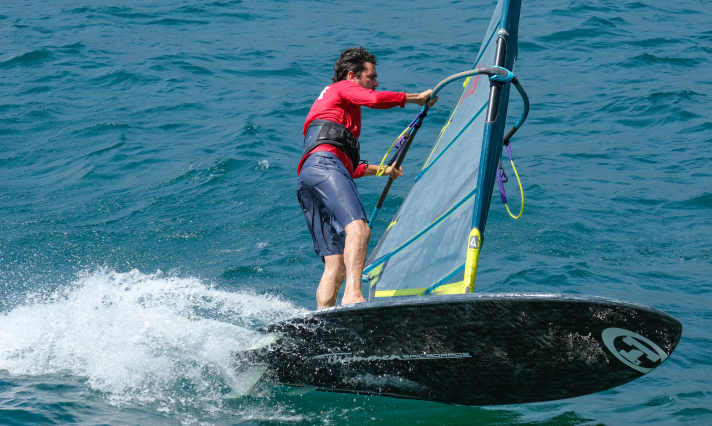
You have also installed a three-fin setup - rather unusual for this board category?
That's right. The idea came partly from the conditions with shallow sandbanks at my partner's home spot - but also from the idea of making the board more controllable in stronger winds. A large, deep fin creates a lot of lift, which beginners often can't handle. The three-fin setup makes it easier to go upwind and provides lateral support - without needing a lot of speed first. And you don't have to fight against the powerful lift of a long fin
And then there are the step rails - what's behind this design?
The step rails were an idea from the "I've-seen-this-before" box. They enable a flatter deck contour. This can be interesting for surf SUPs or if someone wants a flatter deck on a waveboard. I have adapted this for freeride, for a thinner and more profiled rail contour. For many riders, this means lighter, easier glide surfing with good performance. Thick rails require more effort and technique, but I wouldn't use step rails on very performance-orientated boards. In addition, step rails on wider freeride boards allow for a more central, less demanding foot strap position, while still being comfortable in the straps. They also make the board stiffer - that's a nice side effect. And yes: I think they look cool.
What is the feedback on your Glide design?
The variety of people who have given this board a chance is impressive - from weekend riders to hardcore enthusiasts. Many report that it has massively changed their time on the water. They ride more often, on more days, with less frustration - and develop faster as a result. Some use the Glide to complement their other boards, for others it's a one-board solution.
Peter, thank you very much for the interview and your fascinating insights!
With pleasure!
JP-Australia Magic Ride or Super Lightwind? Shaper Werner Gnigler gives you first-hand information here.
We met JP shaper Werner Gnigler at Lake Garda and asked him about the JP Super Lightwind that we tested for surf 8/2025 and also about the largest freeride board, the Magic Ride 158, which is also suitable as a light wind planing board.

In addition to the Super Lightwind here, you also have a similarly sized Magic Ride in your programme. How is it positioned within your range?
The largest Magic Ride with 158 litres is clearly intended as a transition board - i.e. as the first gliding board after the beginner board. It makes it really easy to start gliding. It is slightly longer than the other Magic Rides, has enough volume and all the necessary footstrap positions so that you can find the right setting for every riding ability. This makes passive planing in particular easier.
The 158 differs significantly from the smaller models in the Magic Ride range. It is not simply an upscaled model, but has been deliberately built a little longer. We wanted to create a board that is specifically designed for anyone switching from a beginner board to a planing board. After all, this is the biggest hurdle in our sport. You learn quickly on the typical beginner boards with daggerboards, often with small sails. But the step to a real planing board is a completely different story. You not only need time and patience, but also the right conditions - and the right equipment. But once you're gliding, it's all about you - then you become a windsurfing fan, no question about it. And that's exactly what it's all about. You have to overcome the so-called "glide hurdle" - and this is only possible with a board that starts gliding early and stably. The Magic Ride 158 is ideal for this.
The Super Lightwind is aimed at surfers who are already confident in planing winds
The board you're looking at right now - the Super Lightwind - is aimed at a different target group: surfers who are already confident in planing winds, are a little heavier, ride large sails or live in a spot with little wind. We have now launched several generations of this board on the market and it has always been one of the most successful boards in our programme. As a single shape, it was consistently very strong in terms of sales figures because it simply serves a large target group: surfers who want to be sporty even in light winds.
After all, it's not just about "somehow" travelling across the lake - you want an experience. The board should fly vividly over the water and create a really sporty riding experience. Especially with such large boards, it's not easy to realise this in the shape. But that's exactly what we always had in mind with the Super Lightwind.
What alternatives are there in this size range? What about a large supersport or slalom board - and how exactly is the Super Lightwind different?
The largest supersport and slalom boards have significantly less volume and are not as wide. The Super Lightwind measures 92 cm - the largest Slalom is around 85 cm, the Supersport I think somewhere around 82 cm. There is a clear difference. And we all know that: Width means gliding surface - and gliding surface makes you glide. In addition, the Super Lightwind is slightly longer than a slalom or supersport board. This helps to overcome the planing threshold earlier, especially in light winds and with large sails.
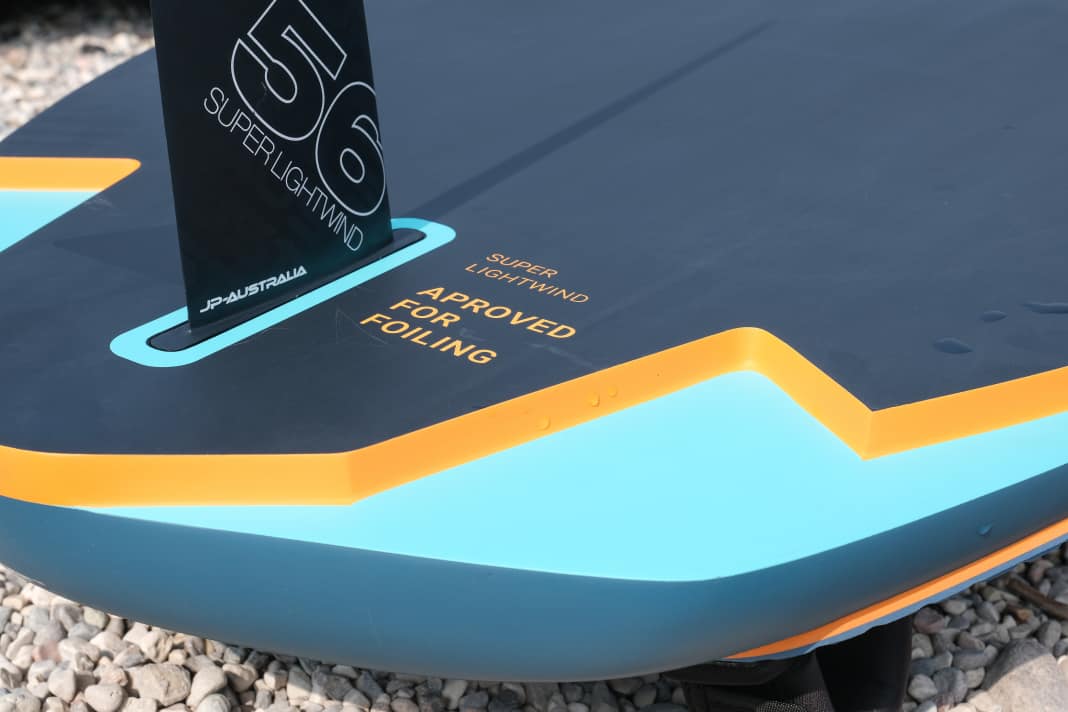




There is always a recommended range of sail sizes for boards. What is realistic here, especially in combination with the 56 cm fin that comes as standard?
Upwards you can sail anything that is common - up to 9 m² is no problem. The different sail manufacturers have different models, but 9 m² is definitely a solid upper limit. I would say that from around 7.7 m² the setup makes sense. For example, if you're sailing an 8.7 m² sail - that would be ideal. That fits perfectly with the 56 mm fin and the board layout. With a 7.7 sail and strong winds, the fin is almost a bit big. No other board model in this segment has such a large fin as standard. This means you are well equipped for light winds with large sails - especially for heavier surfers. The board is usually too big for lighter riders, who don't need that much volume. The large fin together with the wide surface also ensures that the board glides stably through wind holes.
The JP-Australia Super Lightwind compared to a slalom board
Overall, the Super Lightwind looks a bit thinner than a slalom board - especially in the tail. Even compared to the Supersport?
Yes, the Supersport is relatively similar, but we have made the deck shape of the Super Lightwind even more harmonious compared to the previous generation. Slalom boards usually have very "boxy" rails, so you stand with your heel on the very outside. This works well with boards that are ridden with a lot of pressure, such as in slalom. You have to push hard against it.
You mean the area from the strap to the rail?
Exactly, the so-called shoulder. With the Super Lightwind, we wanted you to stand more comfortably - precisely because it is also suitable for foiling. With angular rails, you have zero control when foiling, either your heel is too low or you are standing completely flat on the deck - neither of which is ideal. With an even deck shape, the different footstrap positions can be utilised sensibly. For example, if I'm riding in the inside strap position - which is not intended for slalom boards - I need an evenly shaped deck so that I'm always comfortable.
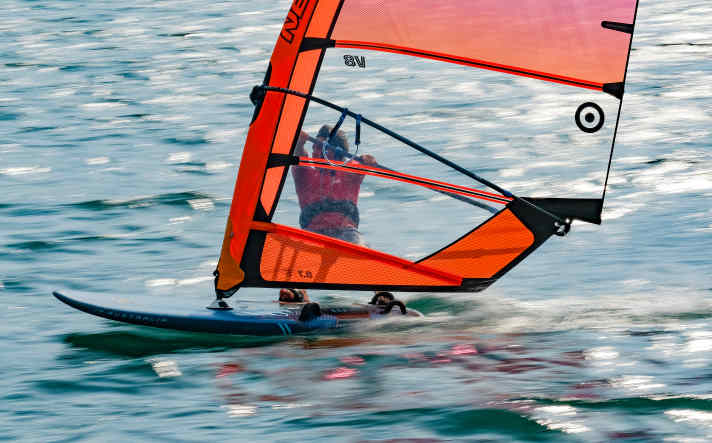
The Lightwind looks almost slalom-like at the tail - but the volume taper is less at the front, isn't it?
Yes, it has a more even thickness. We only have a slightly deeper mast track. The board is longer overall and has a more even volume distribution, which makes passive planing much easier. Slalom boards, on the other hand, have a lot of volume in the tail and very little in the bow - because riders actively pump themselves into planing. This works for sporty surfers who know what they are doing. However, our target group wants to glide passively - especially with large sails, which are more difficult to handle. If there is too little volume at the front, the board sinks too low - and that makes the planing start even more difficult. Thanks to the even volume distribution and the longer outline, the board overcomes the planing threshold much more easily.
I recently rode an 85 cm wide slalom board, which was really difficult when planing. If we look at the underwater hull here - what specifically distinguishes it from the largest slalom board? Rocker line, cutouts, etc.?
The crucial question is always: How much usable gliding surface do I really have? Cutouts are important for extremely wide boards - like here or for large slalom boards. They not only reduce the wetted area in the tail, but above all improve control in stronger winds. If a board with a massive tail without cutouts tips slightly onto the leeward edge, counter-pressure is immediately created and it rocks from windward to leeward - making it unstable. Cutouts break this effect. With the Super Lightwind, however, we have not reduced the surface area as radically as with a slalom board, where the cutouts often extend far forward.
Because you want extreme release with slalom boards?
Exactly. But you still need enough surface area around the fin - otherwise you have no fin pressure. If we take too much away from the fin during development, you can feel it immediately: suddenly there's no more feedback. The large fin, as used in the Super Lightwind, needs counter pressure - more than a high-tech slalom fin, which is much faster. That's why we don't use the deep double steps found on slalom boards. Although they would give more release, they would also take away volume - which would be at the expense of lift when planing or jibing. It is a compromise between planing area and reduced wetted area. By the way: Even the small cutouts at the tail have a noticeable effect. If you were to simply fill them in, the board would be more sluggish. The glide feeling is particularly important with a large board - it should feel small and agile as soon as it glides. This is exactly where such subtleties come into play.
You mentioned passive planing - is this also evident in the rocker line?
Yes, definitely. The flat zone in the tail is about 80 cm long on all performance boards - this is standardised. But the difference lies in the transition to the curve in the mast foot area. On a longer board, this curve is more elongated - the water glides through it more easily. A strong bend pushes water in front of it - you have to actively pump to overcome it. A flat curve allows the water to "flow through". In the glide area at the back, all boards tend to ride with less V - for high water position and speed. We use a little more V at the front - this helps when touching down in choppy water and when edging up for the jibe, especially with a wide board.
But the Super Lightwind isn't that much longer than a slalom board, is it?
No, it measures around 2.38 metres - the largest slalom boards are between 2.25 and 2.28 metres. Funnily enough, the slalom boards with less volume are often longer than the larger ones - simply because in slalom you want to have as little surface area as possible at the front of the large boards that could slow you down. But even the sportiest freerider doesn't ride at the absolute limit like a World Cup rider.
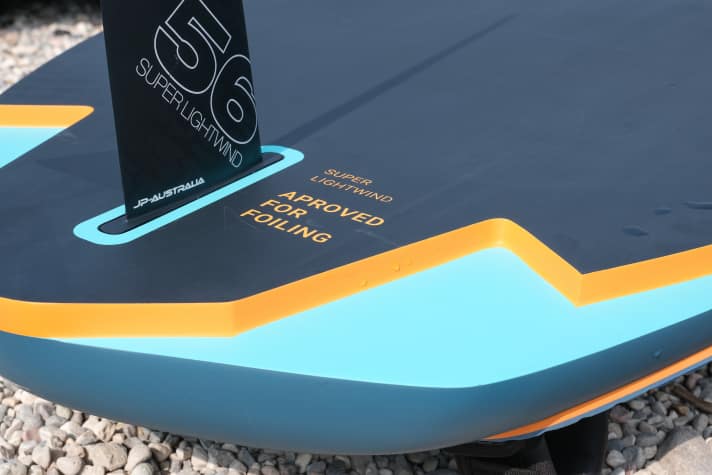
What can be said about the railshape? The rails look less bulky than on the predecessor.
That's right. As already mentioned, the deck shape is crucial - but of course it also influences the underwater hull. We have a clear, defined edge at the back and a bit more "tucked under" at the front so that you can stand comfortably and get through the jibe well. The board has to work in all strap positions - inside and outside. With a slalom board, there is only one: the full-throttle position on the outside.
I know the previous version of the Super Lightwind. It still had quite boxy edges and a very pronounced outline at the rear.
Exactly. Back then, the rear foot was either in the full throttle position - or uncomfortable. The angular rails were also not ideal for the inside footstrap position. We have now revised all of this. The predecessor was already very successful - but the level is now so high that even small optimisations can extend the range of use and increase riding fun. That's what further development is all about.
And what would you say about the planing behaviour - specifically in knots? For example, with a rider weighing 85 kilos and an 8.7 m² sail?
Around ten to 12 knots - with slight pumping. That's a realistic figure. With a foil, you might get going at two to three knots less - but that's a completely different riding experience. You glide off quickly, but you may only be travelling at 15 km/h. The Super Lightwind is made for precisely those conditions where many other boards don't yet planing - and once it is planing, it remains stable in riding mode. That's when the airstream kicks in, the board flies over the water and the fun begins.

